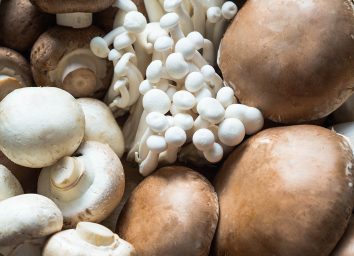What Is Umami? A Chef Explains Why It's Hard to, Well, Explain

Think about all the words you can use to describe the taste of something—savory, sugary, spicy, and bland are just a few that are commonly used. In the U.S., there are four words that we often use to compartmentalize the taste of food: sour, sweet, salty, and bitter. But what's the word you use to describe more complex flavors such as the ones prominent in various types of cheese, miso, and even mushrooms? The answer is umami.
In the past decade, umami has evolved into a buzzword. The word was discovered by Japanese chemist Kikunae Ikeda in 1907 after he decided to take a deeper dive into the molecular composition of one of the ingredients in dashi, a stock that's widely used in Japanese cooking. The ingredient he closely examined was a variety of seaweed, and the component driving the indescribable taste was glutamic acid. He coined it umami after the Japanese word for delicious, umami. The name for the "fifth taste" as it's often referred to didn't emerge into the English language until the late 1970s, and still, many make it through life without having any knowledge of it.
For further clarification on what umami is, Mareya Ibrahim, TV chef and author of Eat Like You Give a Fork: The Real Dish on Eating to Thrive lends insight on which foods and spices fall under the categorization.
What is umami? How would you describe the fifth taste?
"It's often described as meaty or savory, but it comes from foods that are naturally high in glutamic acid," says Ibrahim.
Glutamate is a molecular compound in glutamic acid. In crystal form, glutamates are referred to as MSG. The amino acid glutamate, however, occurs naturally in several foods.
RELATED: Learn how to harness the power of tea to lose weight.
"What's amazing about it is the studies that show eating umami flavors helps you to feel fuller faster because they're so satisfying and pleasing to the palate," says Ibrahim. "That could explain why ketchup and salsa are our two most popular condiments—they're made with tomatoes, which is umami."
What foods and spices would you say have the umami taste?
"Umami is a flavor often attributed to meats, but you can find them in eggs, plant-based foods like tomatoes, mushrooms, miso, seaweed, fish sauce, and soy sauce," she says. "[It's] also in spices and blends like furikake, which contains dried seaweed and bonito flake along with sesame seeds and a myriad of ingredients to season rice in Japan."
So the next time you cannot seem to find the words that would describe that distinctive savory flavor, you'll be equipped to accurately pinpoint the unique taste.








